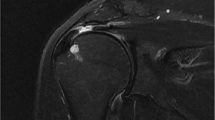Abstract
The standard technique for restoring footprint after full-thickness tears of the rotator cuff includes double-row or transosseous-equivalent techniques. However, the anatomically typical bird’s beak shape and profile of tendon insertion may not be originally restored and biomechanics may be altered. In this report, the authors describe a technique that involves creating two intratendinous stitches at different levels of the torn tendon. The first passes through the bursal-side layer, the second stitch through the joint-side layer. Both stitches may be performed in mattress suture configuration. The anchorage is performed by knotless anchors in order to avoid knots lying within the insertion area. The footprint is restored first medially then laterally by the use of double-row principles. The joint-side suture is anchored within the medially placed anchor. The bursal-side suture is anchored by a laterally placed anchor. The anatomic insertion and restoration of the shape and profile may be enabled by the described double-layer suture technique. Using a double-layer double-row repair may potentially improve functional results of rotator cuff repair constructs.






Similar content being viewed by others
References
Bhatia DN, de Beer JF, van Rooyen KS (2007) The bony partial articular surface tendon avulsion lesion: an arthroscopic technique for fixation of the partially avulsed greater tuberosity fracture. Arthroscopy 23(7):786.e1–786.e6
Bhatia DN, van Rooyen KS, de Beer JF (2007) The “paraglider-wing” sign: an arthroscopic indicator of partial-thickness bursal-surface tears of the supraspinatus tendon. Knee Surg Sports Traumatol Arthrosc 15(6):790–793
Burkhart SS (1994) Reconciling the paradox of rotator cuff repair versus debridement: a unified biomechanical rationale for the treatment of rotator cuff tears. Arthroscopy 10(1):4–19
Burkhart SS (1995) The deadman theory of suture anchors: observations along a south Texas fence line. Arthroscopy 11(1):119–123
Clark JM, Harryman DT 2nd (1992) Tendons, ligaments, and capsule of the rotator cuff. Gross and microscopic anatomy. J Bone Joint Surg Am 74(5):713–725
Curtis AS, Burbank KM, Tierney JJ, Scheller AD, Curran AR (2006) The insertional footprint of the rotator cuff: an anatomic study. Arthroscopy 22(6):609.e1
Fukuda H, Hamada K, Nakajima T, Yamada N, Tomonaga A, Goto M (1996) Partial-thickness tears of the rotator cuff. A clinicopathological review based on 66 surgically verified cases. Int Orthop 20(4):257–265
Huang CY, Wang VM, Pawluk RJ, Bucchieri JS, Levine WN, Bigliani LU, Mow VC, Flatow EL (2005) Inhomogeneous mechanical behavior of the human supraspinatus tendon under uniaxial loading. J Orthop Res 23(4):924–930
Itoi E, Berglund LJ, Grabowski JJ, Schultz FM, Growney ES, Morrey BF, An KN (1995) Tensile properties of the supraspinatus tendon. J Orthop Res 13(4):578–584
Kim SY, Boynton EL, Ravichandiran K, Fung LY, Bleakney R, Agur AM (2007) Three-dimensional study of the musculotendinous architecture of supraspinatus and its functional correlations. Clin Anat 20(6):648–655
Lo IK, Burkhart SS (2003) Double-row arthroscopic rotator cuff repair: re-establishing the footprint of the rotator cuff. Arthroscopy 19(9):1035–1042
Meier SW, Meier JD (2006) Rotator cuff repair: the effect of double-row fixation on three-dimensional repair site. J Shoulder Elbow Surg 15(6):691–696
Park MC, Tibone JE, ElAttrache NS, Ahmad CS, Jun BJ, Lee TQ (2007) Part II: Biomechanical assessment for a footprint-restoring transosseous-equivalent rotator cuff repair technique compared with a double-row repair technique. J Shoulder Elbow Surg 16(4):469–476
Reilly P, Amis AA, Wallace AL, Emery RJ (2003) Mechanical factors in the initiation and propagation of tears of the rotator cuff. Quantification of strains of the supraspinatus tendon in vitro. J Bone Joint Surg Br 85(4):594–599
Spencer EE (2007) Double row double lamina arthroscopic rotatore cuff repair. Tech Shoulder Elbow Surg 8(3):135–140
Sugaya H, Maeda K, Matsuki K, Moriishi J (2005) Functional and structural outcome after arthroscopic full-thickness rotator cuff repair: single-row versus dual-row fixation. Arthroscopy 21(11):1307–1316
Sugaya H, Maeda K, Matsuki K, Moriishi J (2007) Repair integrity and functional outcome after arthroscopic double-row rotator cuff repair. A prospective outcome study. J Bone Joint Surg Am 89(5):953–960
Wolff AB, Magit DP, Miller SR, Wyman J, Sethi PM (2006) Arthroscopic fixation of bursal-sided rotator cuff tears. Arthroscopy 22(11):1247.e1–1247.e4
Yoo JC, Ahn JH, Lee SH, Kim JH (2007) Arthroscopic full-layer repair of bursal-side partial-thickness rotator cuff tears: a small-window technique. Arthroscopy 23(8):903.e1–903.e4
Author information
Authors and Affiliations
Corresponding author
Rights and permissions
About this article
Cite this article
Hepp, P., Engel, T., Osterhoff, G. et al. Knotless anatomic double-layer double-row rotator cuff repair: a novel technique re-establishing footprint and shape of full-thickness tears. Arch Orthop Trauma Surg 129, 1031–1036 (2009). https://doi.org/10.1007/s00402-008-0625-7
Received:
Published:
Issue Date:
DOI: https://doi.org/10.1007/s00402-008-0625-7




